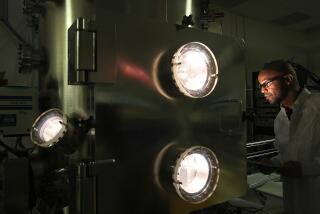As Coachella raged, the L.A. tech world made plans to live on Mars
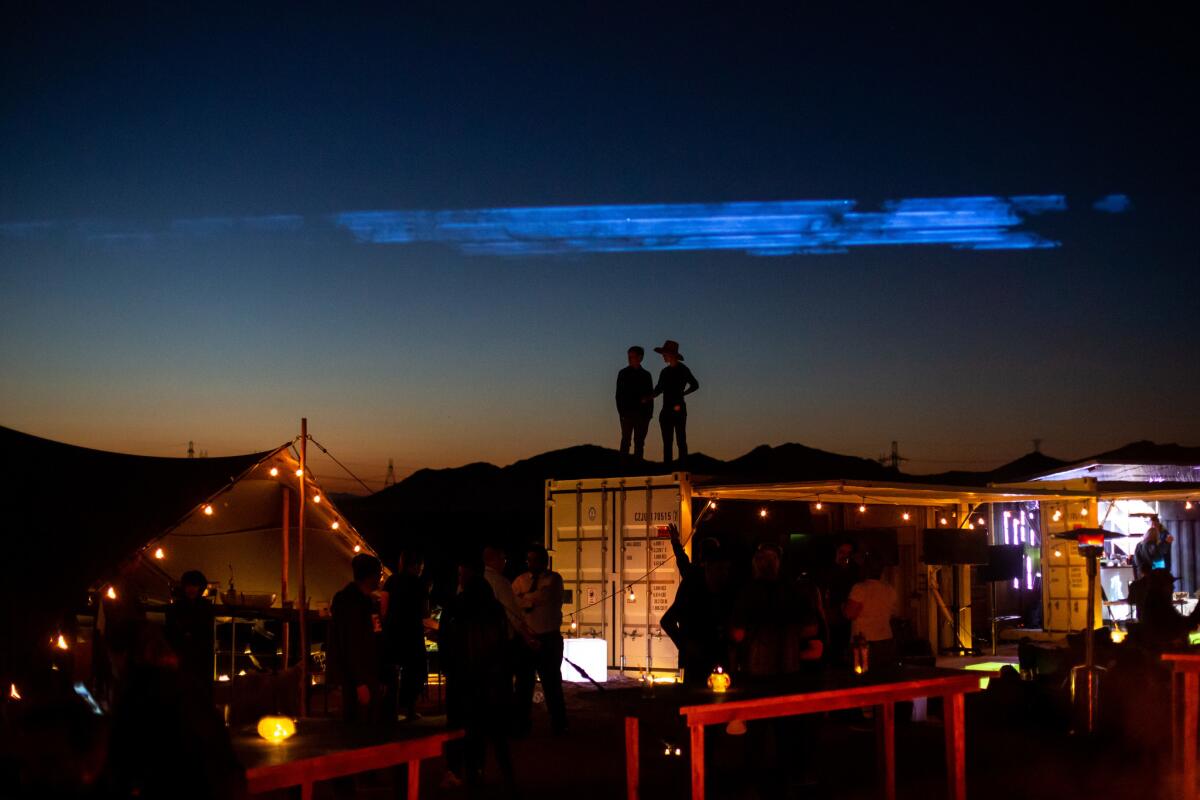
The only in-flight beverages on the 11-seat private jet were bottled water and a genetically modified bacterial slurry designed to prevent the worst effects of hangovers.
A handful of passengers on the short evening flight from Hawthorne to the edge of the Mojave — venture capitalists, a man with a mushroom-based manufacturing company and this reporter — downed the mixture. The pilot, along with two senior SpaceX engineers, politely declined.
At the Apple Valley Airport, a helicopter waited to take us beyond a far ridge, farther from civilization. Miles from paved roads were two tents, a ring of shipping containers and an “H” painted on the dirt marking a makeshift helipad.
One hundred miles to the southeast, masses of festival heads were gathering in the desert for Coachella’s first April weekend. But this small crew of space scientists, synthetic biologists, investors, entrepreneurs and one partygoer with flamethrower had higher ambitions.
By jet, bus and more than a few Teslas, they came to this desolate valley for Betaspace: a one-night, invite-only confab for the not-quite-yet-burgeoning space settlement industry.
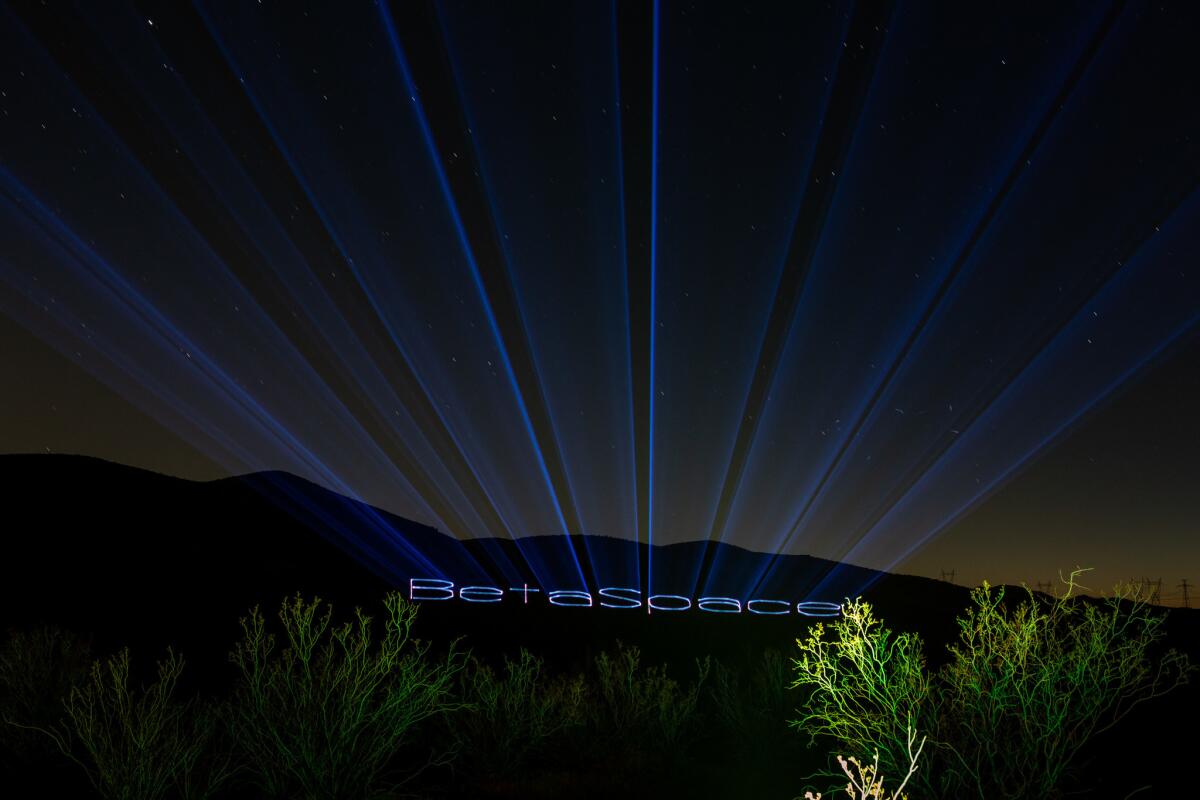
Through sheer force of festive networking, its organizers hoped to spawn the companies and concepts that could allow humanity to establish bases on Mars (or maybe the moon), or “terraform,” as they say, our nearest neighbors into habitable worlds and spin off technologies for us earthbound humans in the process.
To the brains behind the operation, this was also the first step on a new path for the L.A. tech scene. Once a dominant player, back when tech and aerospace were synonymous, the Southland fell from prominence as silicon, software and start-ups concentrated in the Bay Area. Should space colonization actually become a thing, however, Southern California could capitalize thanks to its long history in rocketry and its lively biotech sector.
In another part of the same desert, companies such as SpaceX, Blue Origin and Virgin Galactic launch the rockets that could get us to other worlds. Betaspace aims to figure out how we live once we’re up there.
The invitation promised Betaspace would be the place where “Burning Man and the Consumer Electronics Show collide.” There was a lamb roast and an open bar with space-themed cocktails. And a laser show, projected on the unmistakably Mars-esque hills. At the end of the night, an ailing Honda Odyssey would be ritually incinerated. The man-made anti-hangover microbes flowed freely.
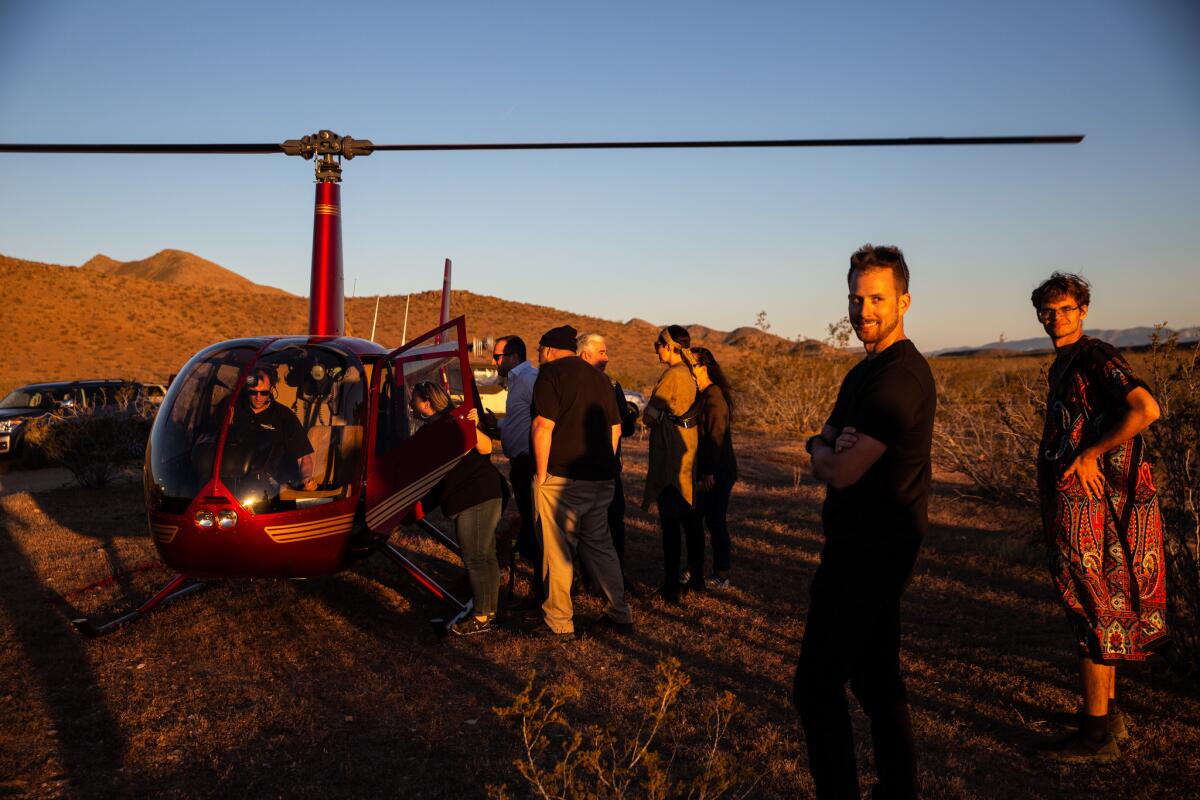
The crowd of about 180 — many from Silicon Valley, some from as far as Switzerland — was roughly split among entrepreneurs in tailored button-downs and business-casual fleeces, scientists in fieldwork-appropriate hiking boot and flannel combos, and Burning Man habitués looking like extras from the “Mad Max” movies.
Most had ignored the style suggestions in the event’s Pinterest look book, heavy on flowing robes, that had been emailed to participants in advance. Bryan Johnson, the man who made hundreds of millions selling Venmo to PayPal and now runs the neural interface company Kernel, rubbed elbows with Brian Armstrong, the chief executive of Coinbase, the world’s leading cryptocurrency exchange.
By the snack table, where legacy chips and salsa sat alongside bright blue cyanobacteria-dusted popcorn, a man in a knee-length fur coat sparked a conversation with a steampunk. One had sold a successful office catering company and was now looking to invest in business models based on catastrophic change. The other worked on developing small nuclear reactors to power spaceships, planetary colonies and Canada.
“How do you keep that fur clean?” the nuclear engineer asked.
“Four Burns in a row, never cleaned it,” the catastrophe investor replied.
A rep from DARPA, the military’s experimental research wing, wore a sequined blazer and horned top hat. A spindly Spock impersonator milled around the edges, looking sternly into the distance. As a DJ played soothing techno music, packs of younger men and women roamed about in full-body elastic silver jumpsuits.
But this crowd wasn’t here simply to look good. They were here to talk space.
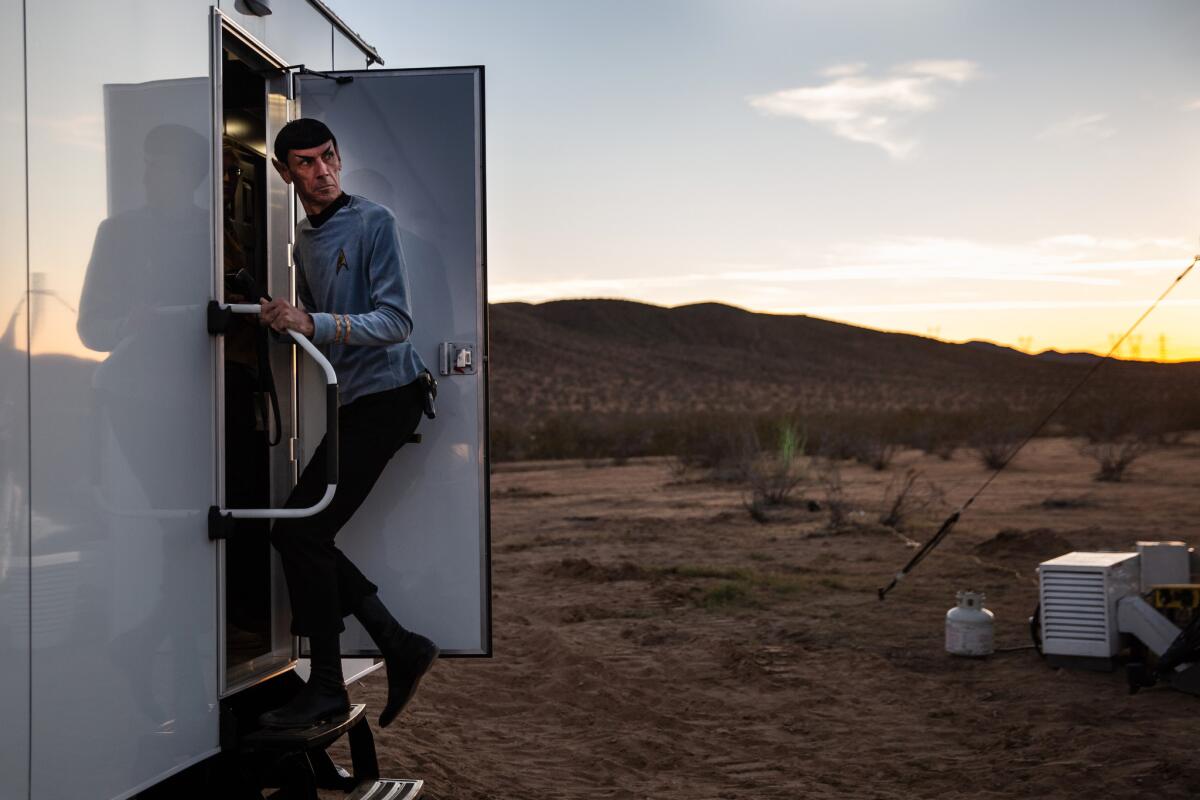
At a typical tech conference, a “moonshot” is a metaphor for a new monetization plan or a bold marketing strategy. Here, shooting for the moon could mean just that.
“I’m going to put an institution of higher learning on the moon,” said Bruce Pittman, a longtime NASA engineer at the agency’s Ames Research Center in Silicon Valley. He hoped it would serve “as a proving ground and as a talent pipeline for the expansion of human presence across the solar system.”
A sense of fast-arriving crisis — climate change, mass starvation and displacement, water wars, poisoned landscapes — drove much of the talk, paired with a hope that some salvation might lie in space, both as a release valve for our pent-up humanity and a harsh proving ground for tech that could carry us earthlings through the hard times.
“Imagine if we live in a nature reserve — forests, meadows, lovely streams. We don’t go building an industrial plant in the middle of that forest,” said Jim Keravala, the chief executive of OffWorld, a Pasadena company that’s building industrial robots for space. “Earth is sitting in a nature reserve called the habitable zone of our star.”
He wants to zone the planet for “residential and light industry only,” and take the dirtiest industrial work into the asteroid belt that orbits the sun between Mars and Jupiter.
These kinds of moonshots don’t come cheap.
“I’m interested in figuring out whether I can get my money back in my lifetime,” said Eric Anschutz, an angel investor. “That probably distinctly means not investing in terraforming.”
His interests lie in the terrestrial byproducts of space expansion, such as how NASA technology led to LASIK surgery and high-efficiency solar panels, or how pharmaceutical companies today regularly buy berths on rocket launches to grow purer crystals in microgravity.
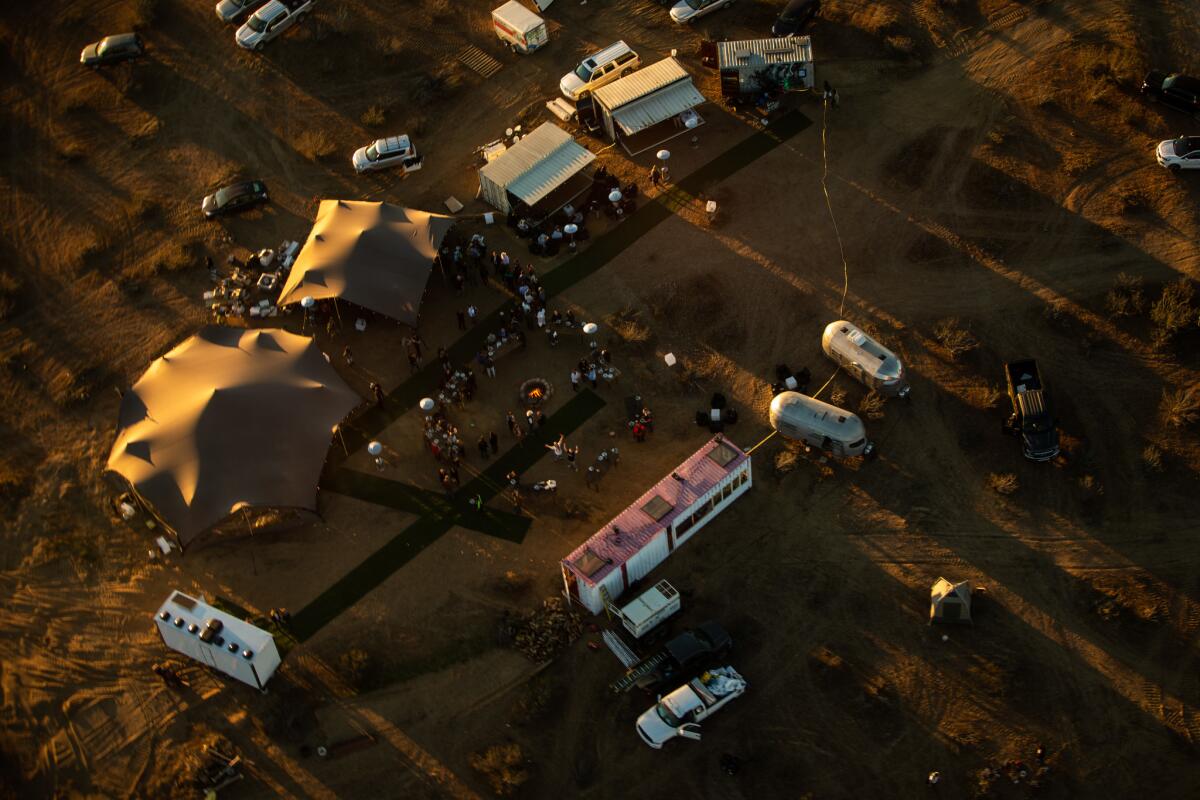
As the sun set and the stars began to show in the desert sky, John Cumbers, the event’s impresario, gathered everyone into the main tent. His research into inducing temporary comas for long-distance space travel had earned him an opportunity at NASA, but he had moved away from space to build a networking business for the synthetic biotech business. He dreamed up Betaspace last year while gazing at the stars on a trip to Malaysia.
He reflected on how he was married, had two kids and a house in the Silicon Valley suburbs. And a realization hit him: “I’m going to be 40 next year. What the hell happened to my vision for settling the solar system?”
He came back to California, rented an RV and drove down to L.A. from his home to scout locations.
While he was in the area, he stopped by Mothership, the downtown Los Angeles biolab and prototyping warehouse run by Soylent founder Rob Rhinehart.
“John came to me and said he wanted to build a futuristic city in the desert,” Rhinehart said. As chance would have it, Rhinehart had purchased a 3-acre parcel of land in the high desert for $3,000, sight unseen, thinking it might serve as a nice spot for stargazing. “When I got out there the first time, it felt like Mars — just being on that plain all alone with the mountains around you and the stars above you, there’s a lot of good energy there. When John said he needed a site, I was like, ‘Oh, you can use mine for free.’ ”
A little more than a year later, Betaspace was born — and Cumbers sounded as if he was working for the chamber of commerce.
“The reason that there is no space settlement industry is because there is no market out there,” Cumbers said. “We all know that in a thousand years we’re going to have people living on the moon or Mars. In a hundred years, I put the probability at 75%. What about in 10 years? I put about 5%, maybe 10%, chance of that.
“We are going to create that market. We’re going to build this community, and this community is going to make the sustainable settlement of space a reality,” Cumbers said.

Chris McKay, a 30-year NASA veteran and one of the leading proponents within the agency for building permanent human settlements off Earth, was a little less bullish.
“When John invited me, I came without even knowing what this was,” he said. “And if I knew, I probably wouldn’t have come, because I’m representing the old guard, I’m representing NASA scientists.”
When McKay said he wasn’t interested in generating revenue from the moon or Mars, the crowd booed. They responded more favorably to his belief that private contractors should handle logistics and let NASA hew to its roots as a science organization, rotating researchers out of moon and Mars bases like researchers in Antarctica.
A senior SpaceX engineer took questions about the company’s Mars ambitions as the crowd grew increasingly rowdy.
The bar ran out of turmeric-carrot juice for its mezcal cocktail, and the privately jetted guests peeled off to catch their flights home.
As the DJ played “The Final Countdown,” the unlucky Honda Odyssey was set upon by the flamethrower. In seconds, flames engulfed the practical family car, and explosions — the air bags? — sent out ear-ringing shock waves.
The heat and caustic smoke pushed the crowd back. But even with a burning Odyssey in front of them, many were still looking up at the stars.
Follow me on Twitter: @samaugustdean

